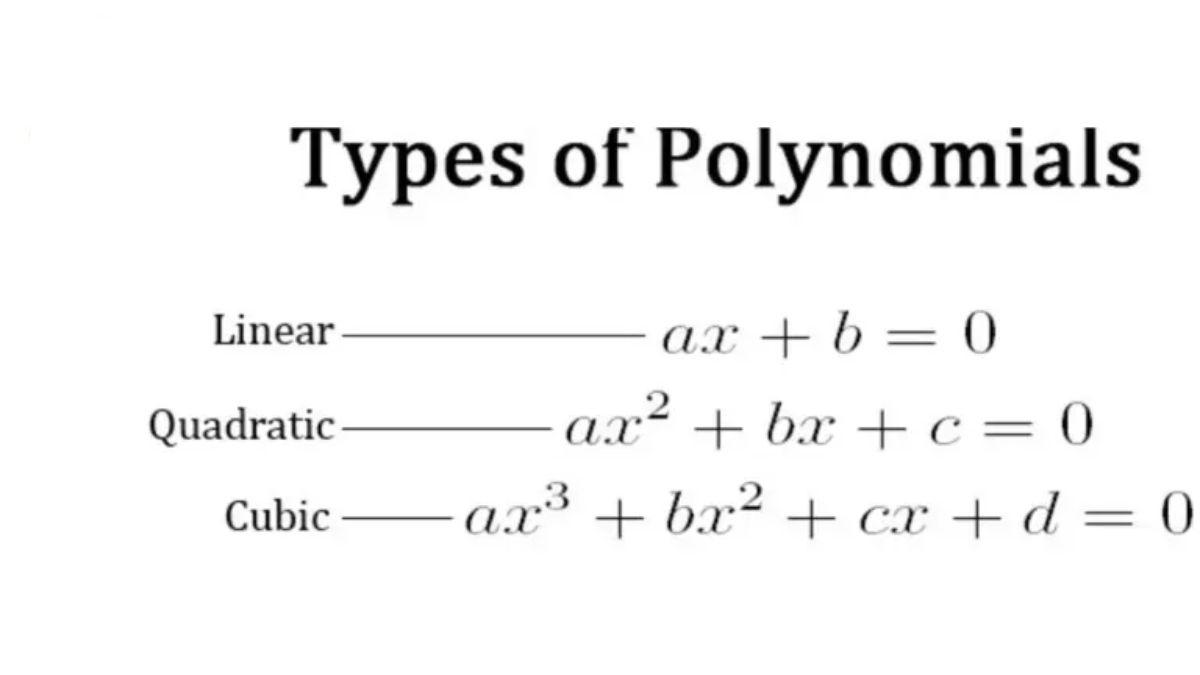A polynomial is a mathematical equation made up of indeterminates (also known as variables) and coefficients. The variables and coefficients in a polynomial are bound together by addition, subtraction, multiplication, and non-negative integer exponentiation of variables. x² + 4x + 7 is an example of a polynomial of a single indeterminate x. x³ + 2xyz² + yz + 1 is a three-variable polynomial example. In this article, we will learn about what is polynomial in great length.
Polynomials
A polynomial is a mathematical expression that represents a sum of terms, each consisting of a variable raised to a non-negative integer power and multiplied by a coefficient. A polynomial is a mathematical expression with one or more terms, with each term being a result of constants, variables, and non-negative whole number exponents. Put simply, it consists of numbers, variables, and their exponents, linked by addition, subtraction, or multiplication.
Polynomials can be found in a variety of fields of mathematics and science. For example, they are used to encode a wide range of problems, from simple word problems to complex scientific problems; they are used to define polynomial functions, which appear in settings ranging from basic chemistry and physics to economics and social science; and they are used to approximate other functions in calculus and numerical analysis.
Polynomial Definition
Have you ever wondered what is a polynomial? A polynomial is a mathematical expression consisting of variables (also known as indeterminates) raised to non-negative integer powers, combined through addition, subtraction, and multiplication by constants. In simpler terms, a polynomial is a sum of terms, where each term consists of a coefficient multiplied by one or more variables raised to non-negative integer exponents.
The term polynomial comes from the combination of the Greek words ‘poly’ meaning ‘many’ and ‘nomial’ meaning ‘terms’, therefore creating the phrase “many terms”. A polynomial may contain multiple terms, but it is not unlimited. You can understand the meaning of variables, coefficients and exponents by going through the examples given hereunder.
- Constants: 1, 2, 3, 4,….. etc.
- Variables: a, c, g, h, x, y, etc.
- Exponents: Example: 3 in x³ etc.
Polynomial General Form
The general form of a polynomial is:
Here:
- represents the polynomial as a function of .
- is the variable.
- is the highest non-negative integer exponent (degree) in the polynomial.
- are constants called coefficients.
Degree of Polynomials
The degree of a polynomial means the highest exponent value a polynomial equation have. Therefore, a polynomial with one variable and the highest exponent is known as the degree of the polynomial. Polynomials can have various degrees, and they are classified based on their degrees:
- Zero polynomial: Its degree is not defined (e.g., 6)
- Constant Polynomial: Degree 0 (e.g., ).
- Linear Polynomial: Degree 1 (e.g., ).
- Quadratic Polynomial: Degree 2 (e.g., ).
- Cubic Polynomial: Degree 3 (e.g., ).
- Quartic Polynomial: Degree 4 (e.g., P(x)=2x4+7x3+3x2+2x+1)
- Quintic Polynomial: Degree 5 (e.g., P(x)=x5+9x4+12x3+7x2+5x+6
The degree of the polynomial is the power of the leading term or the highest power of the variable. This is accomplished by placing the polynomial terms in ascending order of power. They can be divided into four categories based on the degree of the polynomial. They are, indeed Zero polynomial, Linear polynomial, Quadratic polynomial, Cubic polynomial
Polynomial Formula
A polynomial in a single indeterminate x can always be written (or rewritten) in the form
Where an, an-1, an-2, ……………………, a1, a0 are called coefficients of xn, xn-1, xn-2, ….., x and constant term respectively and it should belong to real number (⋲ R). The word “indeterminate” means that x represents no particular value, although any value may be substituted for it. The mapping that associates the result of this substitution to the substituted value is a function, called a polynomial function.
This can be expressed more concisely by using summation notation:
That is, a polynomial can either be zero or can be written as the sum of a finite number of non-zero terms. Each term consists of the product of a number – called the coefficient of the term – and a finite number of indeterminates raised to nonnegative integer powers.
What are Terms of a Polynomial
Polynomials are fundamental in mathematics and have applications in various fields including algebra, calculus, geometry, physics, engineering, and computer science. They are used to model and solve a wide range of mathematical and real-world problems.
Types of Polynomial
Polynomials are classified according to the number of terms they contain. There are polynomials with one, two, three, and even more terms. Polynomials are classed as follows based on the number of terms:
Monomials
A monomial is a polynomial expression with a single term. For instance, 4z, 6x, 2x, and 18p. Furthermore, 8x + 9x + 5x is a monomial since it is made up of like elements that add up to 22x.
Binomials
They are polynomials that have two dissimilar terms. 8x + 4×9, for example, is a binomial because it contains two dissimilar components, 8x³ – 4x and 10pq + 13p².
Trinomials
They are polynomials that have three dissimilar terms. 2x + 9x5– 6x² and 22pq + 8x² – 10 are two examples of trinomials.
Quadronomial
The polynomials that contains four terms in its euqation are known as Quadronomial polynomials. Examples of Quadronomial polynomials are 2x + 9x5– 6x²+7
Pentanomials
Pentanomials are the polynomials that contains exactly five terms in their equation. For example, 2x + 9x5– 6x² + 4x³ + 7
Polynomial Equations
Polynomial equations consist of several constants and variables combined in an expression. A common way to write a polynomial equation is by placing the term with the highest degree first and ending with the constant term.
The example of a polynomial equation is: a4 +3a3 -2a2 +a +1 = 0
Polynomial Function
A polynomial function is one that uses only non-negative integer powers or positive integer exponents of a variable in an equation such as the quadratic equation or the cubic equation. 2x+5 is a polynomial with an exponent of one, for example.
In general, a polynomial function is often referred to as a polynomial or polynomial expression, depending on the degree of the function. The highest power found in a polynomial is its degree. In this article, you will learn about polynomial functions, including zero, one, two, and higher degree polynomials, as well as their expressions and graphical representations.
Properties of Polynomials
A polynomial expression is made up of terms that are linked together by addition or subtraction operators. Various characteristics and theorems regarding polynomials vary depending on the type of polynomial and operation used. Here are a few examples.
Property 1: Division Theorem
If a polynomial P(x) is divided by another polynomial G(x) and yields a quotient Q(x) along with a remainder R(x), then,
P(x) = G(x) • Q(x) + R(x)
Where R(x)=0 or the degree of R(x) < the degree of G(x)
Property 2: Remainder Theorem
If P(x) is divided by (x – a) with remainder b, then P(a) = b.
Property 3: Factor Theorem
A division of polynomial P(x) by Q(x) yields R(x) without any remainder only when Q(x) is a factor of P(x).
Property 4: Bezout’s Theorem
Polynomial P(x) is divisible by binomial (x – b) if and only if P(b) = 0.
Property 5: Intermediate Value Theorem
If P(x) is a polynomial and P(x) is not equal to P(y) for x < y, then P(x) covers all values between P(x) and P(y) within the interval [x, y].
Property 6
If a polynomial P can be evenly divided by two mutually prime polynomials Q and R, then it can also be divided by the product of Q and R.
Property 7
If a polynomial Q divides polynomial P, then any root of Q is also a root of P.
Property 8
If F(x) = a0 + a1x + a2x2 + …… + anxn is a polynomial such that degree of (F) = n ≥ 0 then, F will have at most “n” distinct roots.
Property 9
If a polynomial P(x) with real coefficients has a complex zero at x = a – bi, then the complex conjugate x = a + bi will also be a zero of P(x). Additionally, P(x) will have x² – 2ax + a²+ b² as one of its factors.
Property 10: Fundamental Theorem of Algebra
All single-variable polynomials with complex coefficients, except constant ones, must have a complex zero.
Property 11: Descartes’ Rule of Sign
The amount of positive real roots in a polynomial P(x) is equal to or fewer than an even number as the changes in the sign of the coefficients. Therefore, if there are “K” alterations in signs, the number of roots will either be “k” or “(k – a)”, with “a” being an even number.
Algebraic Operations on Polynomials
Different types of polynomials can undergo the basic algebraic operations. The following are the four fundamental operations that can be performed on polynomials:
- Addition of polynomials
- Subtraction of polynomials
- Multiplication of polynomials
- Division of polynomials
Addition of polynomials
To add two terms of polynomials, their degree must be same. One fundamental operation we use to alter the value of polynomials is adding them together. Whether you want to add numbers or polynomials, the fundamental rules don’t change. When adding, align the correct place values and perform the operation.
Nonetheless, when working with polynomial addition, it is necessary to match similar terms together before combining them. If not, the addition rules for polynomials are the same as those for numbers. Look at the example given below.
Example: Add 2x2 + 3x +2 and 3x2– 5x -1
as the degree of both these polynomials are same, so they can be added
while adding two polynomials, we add the coefficients of common terms
So, the answer will be 5x2 – 2x +1
Subtraction of polynomials
As mentioned earlier, subtracting polynomials is closely akin to subtracting two numbers. To subtract one polynomial from another, simply add the negative of the polynomial being subtracted to the other polynomial. Another simple method of subtracting polynomials involves changing the signs of all terms in the second polynomial, and then adding these terms to the first polynomial. Check the following example:
Subtract 2x2 + 3x +2 from 3x2– 5x -1
i.e., (3x2– 5x -1) – (2x2 + 3x +2)
On subtracting, we get
x2– 8x -3
Multiplication of polynomials
The general properties of multiplication on polynomials include commutative, associative, and distributive properties, which can be used with exponent rules to solve multiplication problems. To calculate the product of two polynomials, we simply multiply each term of one polynomial by each term of the other polynomial and then combine all the products.
Example: (2x + 3y)(4x – 5y) = 2x(4x – 5y) + 3y(4x – 5y) = 8x2 – 10xy + 12xy – 15y2
So, (2x + 3y)(4x – 5y) = 8x2 + 2xy – 15y2
Division of polynomials
The division of polynomials is an arithmetic operation where we divide a given polynomial by another polynomial which is generally of a lesser degree in comparison to the degree of the dividend. There are two methods to divide polynomials.
- Long division of polynomials
- Synthetic division
Example: (2x2 + 4x) ÷ 2x
we can take 2x common from both terms: 2x(x + 2)/2x
on eliminating the common factor, we get: x + 2
So, (2x2 + 4x) ÷ 2x = x + 2
Factorization of Polynomials
The factorization of polynomials involves breaking down a polynomial expression into irreducible factors that are multiplied together, with coefficients in the same domain as the original polynomial. Various methods are available for factoring polynomials, including the following: We can choose any of the methods mentioned above depending on the complexity of the polynomial expression.
- Method of Common Factors
- Grouping Method
- Factoring by Splitting Terms
- Factoring Using Algebraic Identities
Examples of Polynomials Based on Degree
Here are some examples of polynomials:
- Constant Polynomial (Degree 0):This is a polynomial with a constant term. It doesn’t involve any variable and has a degree of 0.
- Linear Polynomial (Degree 1):This is a linear polynomial with a degree of 1. It has one term involving the variable raised to the first power.
- Quadratic Polynomial (Degree 2):This is a quadratic polynomial with a degree of 2. It has terms involving , , and a constant term.
- Cubic Polynomial (Degree 3):This is a cubic polynomial with a degree of 3. It has terms involving , , , and a constant term.
- Quartic Polynomial (Degree 4):This is a quartic polynomial with a degree of 4. It has terms involving , , , , and a constant term.
- Polynomial with Fractional Coefficients: This polynomial has fractional coefficients. It’s a quadratic polynomial with a degree of 2.
These examples demonstrate different types of polynomials based on their degrees and coefficients. Polynomials can have various forms and are used to model a wide range of mathematical and real-world situations.
Related Post:












 Greater Than and Less Than, Equal to Sig...
Greater Than and Less Than, Equal to Sig...
 XXV Number- XXV Roman Numerals Definitio...
XXV Number- XXV Roman Numerals Definitio...
 Ordinal Numbers: Meaning, Examples, Appl...
Ordinal Numbers: Meaning, Examples, Appl...









